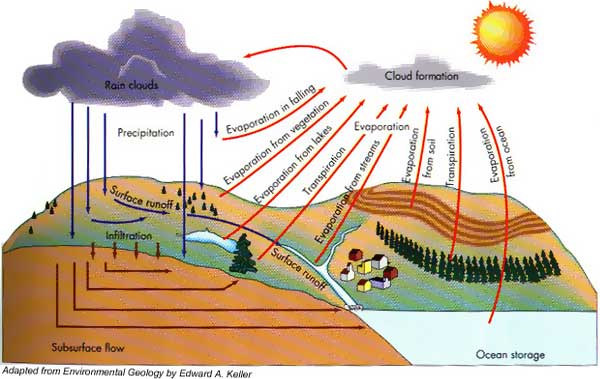
The world's water is in constant motion, flowing downhill by gravity, pumped into the atmosphere by evaporation fueled by Sun's heat, and returned as rain and snow. Except for the oceans, most of it moves underground. The hydrologic cycle is a simple way to represent this motion (Figure 1). Water at the surface (wetlands, lakes, rivers, oceans) evaporates into the atmosphere, leaving impurities behind. Moisture moves around the globe with the weather patterns, and rain and snow condense from it. Some of this precipitation runs back to surface water bodies and some percolates into the ground to become soil moisture. Micro-organisms are constantly purifying this water as it moves in streams, wetlands, and soil. Plants transpire some of this back to the atmosphere, and some continues to percolate down to the water table where it becomes ground water. Ground water flows slowly through the earth, and eventually returns to surface water bodies or to the oceans to start the cycle all over.
As shown in Figure 2, the hydrologic cycle comprises different reservoirs of water: the moisture in the atmosphere at any moment (<0.01% of earth's total water), water in plant and animal tissue (<0.01%), as lakes, rivers, and wetlands (<0.03%), locked in polar ice caps and glaciers (2%), as underground water (4%), and in the oceans and seas (94%) [source: R.A. Freeze and J.A. Cherry, Groundwater, Prentice Hall, 1979].
Water may move rapidly between these reservoirs in the space of minutes or days (for example: plant transpiration, evaporation of rainwater from puddles, the moisture in storm fronts) or it may reside in storage for hundreds, thousands, or even millions of years (for example: water in large lakes, in the oceans, and in deep aquifers).
Almost all parts of the hydrologic cycle are interconnected: for example, the atmosphere and surface water reservoirs are directly interconnected via precipitation, evaporation and plant transpiration; some of the water that infiltrates into the ground returns relatively quickly to the atmosphere via transpiration and evaporation; surface waters can infiltrate into the ground to become ground water or can be fed by ground water (e.g. Batiste Springs, Lava Hot Springs, the middle Snake River).
Because of these interconnections (both natural and manmade), conflicts can arise, for example between users of surface water and ground water. In some cases, ground water extraction from shallow aquifers that naturally discharges into rivers and sustains streamflow in drought years may be responsible for decreased stream flows and inadequate flows for surface water users. Human intervention in the hydrologic cycle can cause similar and related problems. For example, diversions of river water for flood irrigation have had a major impact on local ground water tables, by replenishing aquifers locally by leakage from canals and irrigated fields; as flood irrigation has given way to sprinkler irrigation over recent decades, artificial replenishment from flood irrigation has waned, ground water levels have declined, and conflicts have arisen.
